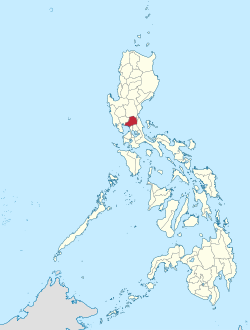
Back Propinsi Bulacan ACE بولاكان Arabic بولاکان AZB Bulacan BCL Bulacan CBK-ZAM Bulacan CEB Bulacan (provincie) Czech Bulacan German Bulakano Esperanto Provincia de Bulacán Spanish
Bulacan | |
|---|---|
From the top, left to right: Barasoain Church, Malolos Cathedral, Bulakan Church, Philippine Arena, Our Lady of Lourdes Grotto Shrine and Bulacan Provincial Capitol | |
|
| |
| Nickname(s): We, the South of Central Luzon Metro Manila Greater Area Cradle of the Nation's Noble Heroes | |
| Motto: Dakilang Bulacan[1] | |
 Location in the Philippines | |
| Coordinates: 15°00′N 121°05′E / 15°N 121.08°E | |
| Country | |
| Region | Central Luzon |
| Founded | August 15, 1578[2] |
| Capital | Malolos |
| Largest city | San Jose del Monte |
| Government | |
| • Governor | Daniel Fernando (NUP) |
| • Vice Governor | Alex Castro (NUP) |
| • Legislature | Bulacan Provincial Board |
| Area | |
• Total | 2,796.10 km2 (1,079.58 sq mi) |
| • Rank | 46th out of 81 |
| Highest elevation | 1,188 m (3,898 ft) |
| Population (2020 census)[4] | |
• Total | 3,708,890 |
| • Rank | 2nd out of 81 |
| • Density | 1,300/km2 (3,400/sq mi) |
| • Rank | 4th out of 81 |
| Demonyms |
|
| Divisions | |
| • Independent cities | 0 |
| • Component cities | |
| • Municipalities | |
| • Barangays | 569 |
| • Districts | |
| Demographics | |
| • Ethnic groups |
|
| • Languages | |
| Time zone | UTC+8 (PHT) |
| IDD : area code | +63 (0)44 |
| ISO 3166 code | PH-BUL |
| Income class[5] | First Class |
| • Assets (2018) | |
| • Liabilities (2018) | |
| • Equity (2018) | |
| • Revenue (2018) | |
| • Expenses (2018) | |
| Website | www |
Bulacan, officially the Province of Bulacan (Tagalog: Lalawigan ng Bulacan; Kapampangan: Lalawigan ning Bulacan; Southern Alta: Lalawigan na Bulacan), is a province in the Philippines located in the Central Luzon region. Its capital is the city of Malolos. Bulacan was established on August 15, 1578, and part of the Metro Luzon Urban Beltway Super Region. This province is a part of the Greater Manila Area.
It has 572 barangays in 20 municipalities and four component cities (Baliwag, Malolos the provincial capital, Meycauayan, and San Jose del Monte the largest city). Bulacan is located immediately north of Metro Manila. Bordering Bulacan are the provinces of Pampanga to the west, Nueva Ecija to the north, Aurora and Quezon to the east, and Metro Manila and Rizal to the south. Bulacan also lies on the north-eastern shore of Manila Bay.
In the 2020 census, Bulacan had a population of 3,708,890 people, the most populous in Central Luzon and the third most populous in the Philippines, after Cebu and Cavite.[4] Bulacan's most populated city is San Jose del Monte, the most populated municipality is Santa Maria, while the least populated is Doña Remedios Trinidad yet the largest municipality in terms of area.
In 1899, the historic Barasoain Church in Malolos was the birthplace of the First Philippine Republic, sometimes described as the first constitutional democracy in Asia.
On November 7, 2018, the Provincial Government of Bulacan bagged its fourth Seal of Good Local Governance award. The SGLG award is a progressive assessment system that gives distinction to remarkable governance performance.[6]
- ^ "Central Luzon Region". Province of Bulacan. Archived from the original on June 29, 2017. Retrieved March 18, 2016.
- ^ Balabo, Dino (August 15, 2013). "PromdiNEWS: Bulacan celebrates 435th founding year". promdino.blogspot.com. Archived from the original on December 22, 2014. Retrieved August 15, 2013.
- ^ "List of Provinces". PSGC Interactive. Makati City, Philippines: National Statistical Coordination Board. Archived from the original on January 11, 2013. Retrieved October 10, 2013.
- ^ a b Census of Population (2020). "Region III (Central Luzon)". Total Population by Province, City, Municipality and Barangay. Philippine Statistics Authority. Retrieved July 8, 2021.
- ^ "Commission on Audit 2018 Report-Bulacan". Quezon City, Philippines: Commission on Audit (COA). Archived from the original on September 23, 2019. Retrieved June 25, 2019.
- ^ "Bulacan, Philippines: News: 08 Nov 2018 - Bulacan reaps 4th SGLG award". www.bulacan.gov.ph. Archived from the original on December 3, 2018. Retrieved December 3, 2018.








